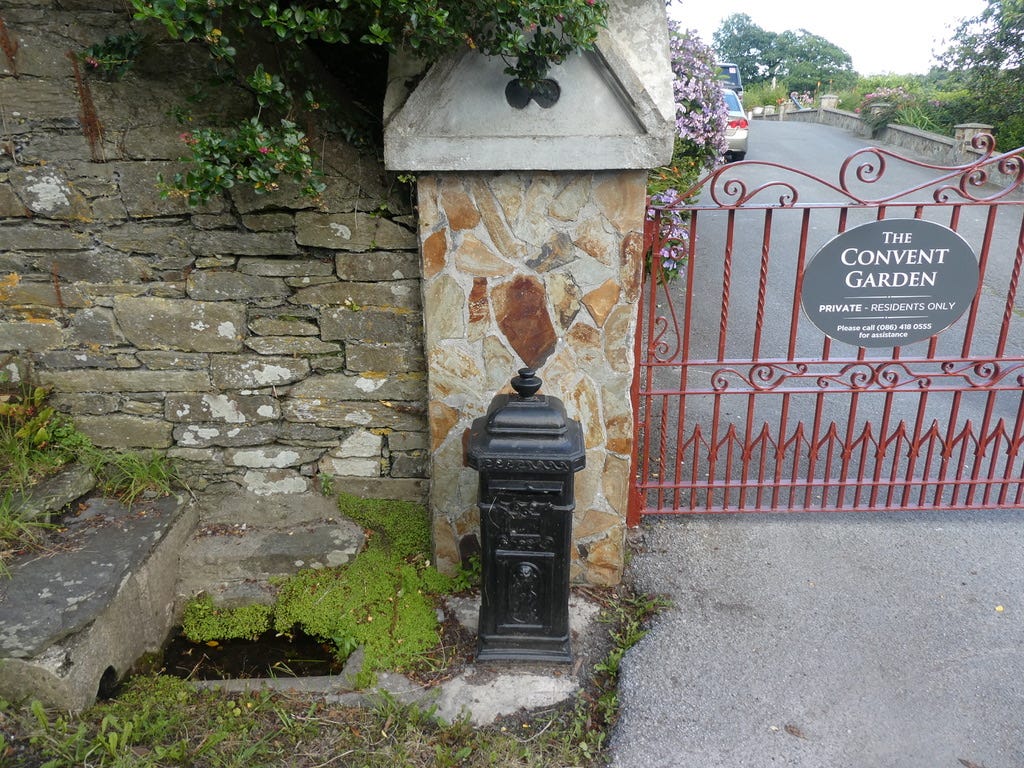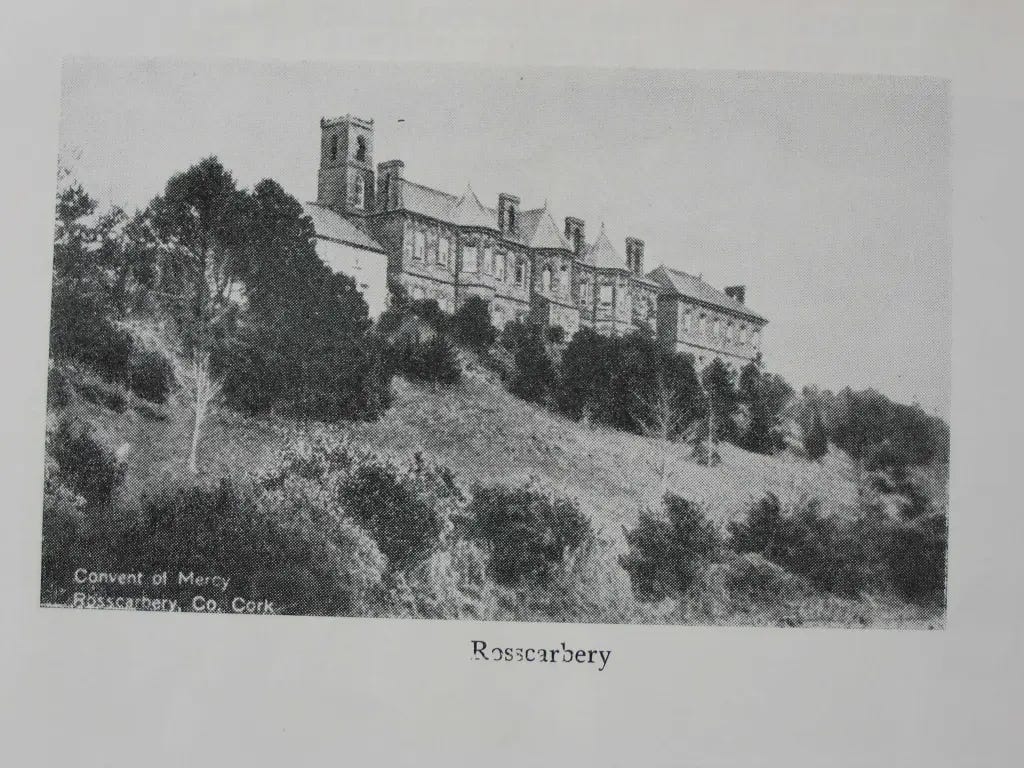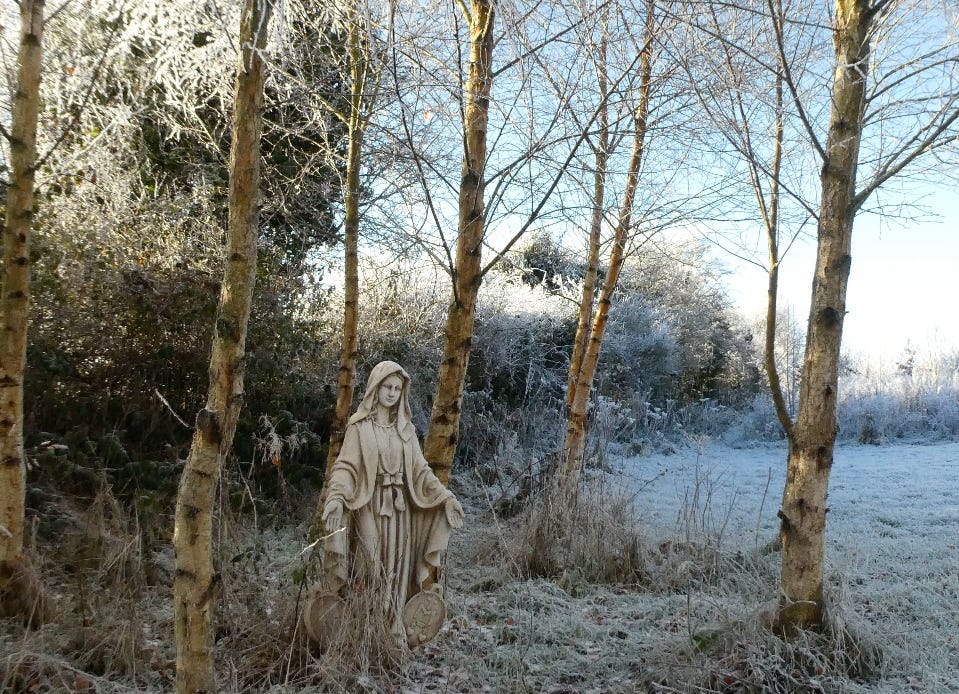St Bridget’s/St Fachtna’s Well, Rosscarbery, County Cork
Some wells are hard to find because they are hidden in remote copses, or lurk under limestone mountain peaks, or nestled somewhere down a muddy track in the corner of a field, smothered by bracken or guarded by suspicious cows. Others, though, are hidden in plain sight. Sometimes this makes things worse.
My daughter and I drove up and down the hill three times, getting stuck in tight corners and reversing into peoples’ driveways, before we found this well. Even when we did find it, we weren’t sure if we had. This seemed to be where it was marked on the map, it’s true. But was this a well? It looked more like a drinking trough. Maybe we had got it wrong again. Or maybe the map had.
But yes, it turned out, this was the well. The clue was the location: it is built into the wall of the former Convent of Mercy, an imposing nineteenth-century building in the little Cork town of Rosscarbery. The convent looms over the town from a hilltop, which gives it, in the wrong light, something of a sinister aspect. There are a lot of old Irish church buildings like this: great grey squat things which peer down across their towns like judgemental aunts. I’ve often wondered why the modern Irish church - as opposed to the early church here, which was responsible for a good deal of beauty - built such ugly and even frightening buildings. This one, in this old photo at least, looks like a haunted house:
Still, the old convent did good work. It housed a school for poor children, and in its early years it provided employment, mainly in weaving and lace-making, for girls and young women. All of this was directed by the resident nuns, one of whom, Mother M. de Sales Dooner, was also its founder and apparently its architect. It seems the haunted house look was her idea, but I’m sure her good works more than made up for it.
I wonder if she was also responsible for the well in the wall? There is not much to it now. A little trough of brackish water covered in pondweed, which nobody would notice if they were not specifically looking for it - or indeed, in my experience, even then:
Very little is known about it, it seems. It’s not even clear which saint - Bridget or Fachtna - it is ultimately dedicated to, and if it was ever a conventional holy well, with rounds and a pattern day, nobody remembers it now. Nobody even remembered it back in the 1930s, when the local schoolchildren recorded what they knew of its folklore for the Schools History Collection. ‘Only very old people believe it to be a holy well,’ wrote local schoolgirl Máire Ní Dhálaigh. Those same old people told Máire about the well’s origins:
There was a Convent situated on the site of the present building at some period of Ireland's Golden Age. One day a nun, believed to be Saint Sera was carrying fire in her apron, and indulged a vain glorious thought while doing so. Immediately her clothes took fire, she repented on the instant, dropped the fire from her, and where it touched the ground, a well of spring water sprang up.
If only my vainglorious thoughts would bring about such instant and obvious repercussions. I’d be a saint by now too.
Máire records a few other good stories about the well for us:
In ancient times when pilgrimages were made to this well, a Protestant bishop determined to stop them. He ordered his men to break the stone slab. They refused, and the story goes that he broke it himself and profaned the well. As a punishment he was deprived of the gift of speech and whenever he attempted to speak, he could only quack like a duck.
An Irish holy well tale can always be relied upon to have a Protestant villain. Still, a quacking bishop is quite some image to carry away.
There are no bishops around here now though; no nuns anymore either. The convent closed in 2015, and was sold for a princely sum to a celebrity wedding planner famous for some TV show or other. The five remaining nuns were redistributed amongst other convents in Ireland. The symbolism would be delicious if it wasn’t also quite sad. Monasteries and convents are in precipitous decline here. If they’re not being closed and flogged off for housing, they are clinging on, with two or three ancient brothers or sisters the last remaining memory of a dead world. Those who can’t wait to see the back of that world - and there are plenty - might stop and think for a moment about what is replacing it. There have been monks and nuns here since before there was a nation. What will the nation become when they are all replaced by celebrity wedding planners?
A few years back, a junk shop near me took delivery of a job lot of items from the local convent, which had been closed. The owner had been asked to go and strip the place before it was sold, and his shop was full of altar rails, fonts, stained glass windows and statues of Mary. I bought one myself, and placed it outside my writing cabin, in the hope of blessings for my words. The Theotokos stands guard under the birches in all weathers now, changing with the seasons, sinking in to the place:
The rise and the fall of faith and time: so it goes. Where it shall go next is anybody’s guess, but the silent wells might be some clue as to how a tired, ancient, unloved thing can be refreshed. You have to go back to the source.









Lovely, this Sunday morning which I learned is the 300th anniversary of Bach's St. John's Passion, a work that I have sung, listened to, and loved, and still love, but listen to... less now, and can no longer sing, unfortunately.
Thank you for making me laugh through my tears ? The wedding planners make me think of Las Vegas, and we know where that is, right ?...
The world one big Las Vegas, is that where we're heading ? I certainly hope not. Las Vegas looks so incredibly... cheap, even with the sophisticated cardboard replicas of Venice installed in it (but I may be wrong, and they may even be gone by now, who knows ?).
Yes, for going back to the source... literally and metaphorically, both together.
It’s been a while since I visited the Abbey. How replenished I am by the spring of your words.
In our home town the convent became a commercial art gallery and wedding venue. Every weekend it’s booked out with people drunkenly celebrating their nuptials. It’s raucous. In the nearest provincial city, a gold rush town, the glorious monastery was turned into swanky apartments. Indeed, one is up for sale: https://www.realestate.com.au/property-house-vic-wendouree-144561296 They have been 'tastefully restored' but the sad thing is they sold off the grounds which framed the building. Now there is a supersized homewares store that abuts one side and a large concrete shopping centre with massive carpark on the other side. The contrast between the world that was and the one that is, is especially sad and stark. Thank you for your humble sanity and faith, Paul.